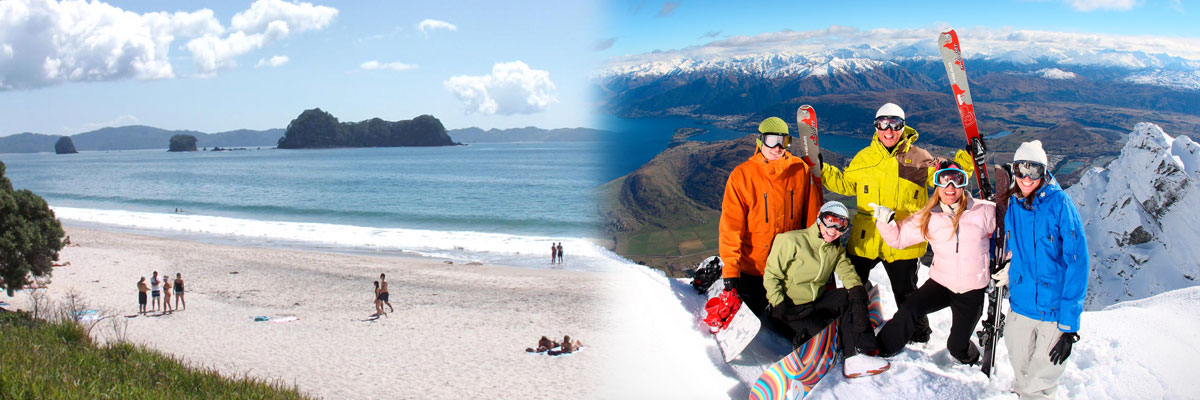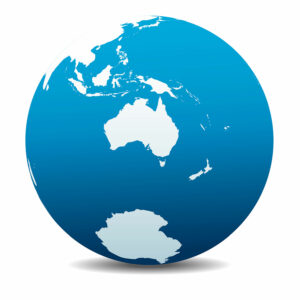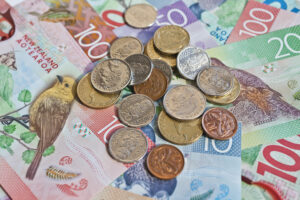Before You Go To New Zealand
Although New Zealand is one of the easiest countries to travel to, contemplating a long haul trip to the other side of the world can be daunting. Here are a few key points that you need to know before you plan your trip, including Visa information.
Before you travel we’ll also give you a free copy of our own Insider Tips guide to New Zealand packed with information that you’ll find useful once you arrive, including our recommendations for things to do in between sightseeing, places to eat and drink, ideas for evenings and more.
 The Geography
The Geography
New Zealand consists of two main islands: North Island and South Island. North Island is where most of the population lives; South Island, being closer to Antarctica, is cooler.
The country has an incredibly varied landscape. You’ll find sweeping coastlines, spectacular mountain ranges, tropical rainforest, steaming volcanos and stunning glacier regions. There is something for everyone, whether you’re looking for head-space in the great outdoors, or the adrenalin rush of high adventurous activities.
New Zealand also has 14 National Parks that showcase more than 30,000 square kilometres of unique nature and breath-taking scenery.
 Time Difference
Time Difference
New Zealand is 12 hours ahead of GMT (Greenwich Mean Time), making it one of the first countries in the world to welcome in each new day.
Like us here in the UK, New Zealand observes Daylight Saving, and so during their summer time (and our winter time) their clocks go forward one hour to GMT+13. Daylight saving begins on the last Sunday in September and ends on the first Sunday of the following April, when clocks are put back to GMT+12.

The Seasons
Being in the Southern Hemisphere, New Zealands seasons are the opposite way around to ours, so December to February are their hottest months, and also the most expensive time to visit. June to September is the peak season for skiing in the ski resorts of Wanaka, Queenstown and Canterbury on the South Island, and the inbetween or ‘shoulder seasons’ often offer the best of both worlds, with better prices, more accommodation options and less tourists while still enjoying bright sunny days and warm weather.
Your Passport
Before travelling to New Zealand, you need to make sure your passport is valid for at least three months longer than your expected departure date.
Visa Requirements for New Zealand
From 1 October 2019, there is a mandatory requirement for British passport holders to obtain an NZeTA (New Zealand Electronic Travel Authority) when travelling to New Zealand.
Applying for an NZeTA is an online process that takes just a few minutes. You will need your passport, a credit card, an email address (you can only apply for one person at a time) and a passport style photograph. It costs $12 NZD to obtain an NZeTA when you apply online at nzeta.immigration.govt.nz
You can also download a free app to your mobile phone in order to apply (search for NZeTA in Google Play or the App Store). You can use the app to scan your passport to instantly upload your details and scan your credit or debit card for ease of payment. The NZeTA costs $9 NZD via the app.
The NZeTA is electronically linked to your passport, which means you will need to travel with the same passport you use when you apply for and obtain your NZeTA.
Other nationality passport holders should check with the relevant embassy.
Alongside this, New Zealand have also introduced an International Visitor Conservation and Tourism Levy (IVL), which funds tourism infrastructure and helps to protect the natural environment. This levy applies to most visitors into New Zealand and will cost $35.
When you apply for your NZeTA, the levy charge (IVL) will be added to the overall total at the time of payment.
Please note: If you experience any issues with their website while using your current browser, then we recommend trying an alternative browser such as Google Chrome or Firefox.
For Silver Fern travellers contemplating stopovers en route to New Zealand or integrating a New Zealand holiday with a longer worldwide tour, a visa may be required.
For a stopover in Singapore you will need to complete a Singapore Arrival Card. ica.gov.sg
For example an Australian tourist visa is necessary for anyone entering the country other than those in transit. Similarly entrants to America should have arranged an ESTA. These can be applied for online or through the Travel Visa Company, one of our trade partners who charge for this service.
 Currency and Credit Cards
Currency and Credit Cards
The currency in New Zealand is the NZ Dollar. The exchange rate varies but as a general guide, there is NZ1.9 / NZ$2.00 to every GBP£1.
You can use all major credit cards in New Zealand, and ATM’s are found as easily as they are in the UK, on most high streets, in shopping malls and in banks. You can also exchange foreign currency at banks, some hotels and bureau de change kiosks.
Do let your bank know you’ll be travelling before you leave home though to ensure that you’re able to use your card overseas.
What to Pack for New Zealand
Holiday packing is always a challenge, especially when you’re going away for longer than a week or two, so we wrote a blog post offering our advice on how to pack for your New Zealand holiday – you can read it here.
New Zealanders are very relaxed when it comes to dress codes – unless it’s a special occasion, most kiwis will wear polo shirts / blouses and lightweight jeans or slacks. So please leave the tiara and top hat at home. If you have packed more than 23kg, you are doing something wrong – give us a call and we’ll put you straight!
Do bear in mind the trains will not accept luggage any heavier than 23kg and hauling around a large suitcases is not a good idea when you are travelling between a considerable number of accommodations.
Remember to pack a good pair of walking shoes, or boots if you’re planning to walk some of the tracks .
 Electronics and Mobile Devices
Electronics and Mobile Devices
You can buy a prepaid Vodafone or Spark sim card at the airport (you’ll see their stand at the end of the Duty Free) or many of the local shop to put in your phone but its always worth checking with your mobile phone provider to see if they offer an overseas package before you leave home.
New Zealand electricity supply runs at 230/240 volts, and they use the same plug as in Australia, with two or three pins. You’ll need to use an adapter for all appliances, which can easily be purchased either in the UK before you travel or once you’re in New Zealand.
Wi-Fi is widely available in most hotels and B&B’s and also in many cafes and eateries.
As far as possible we have endeavoured to make this information as accurate as possible, but we always recommend that you do make sure to double check things like Visa’s / Insurance etc before travel as changes do occur.

 The Geography
The Geography Time Difference
Time Difference Currency and Credit Cards
Currency and Credit Cards Electronics and Mobile Devices
Electronics and Mobile Devices